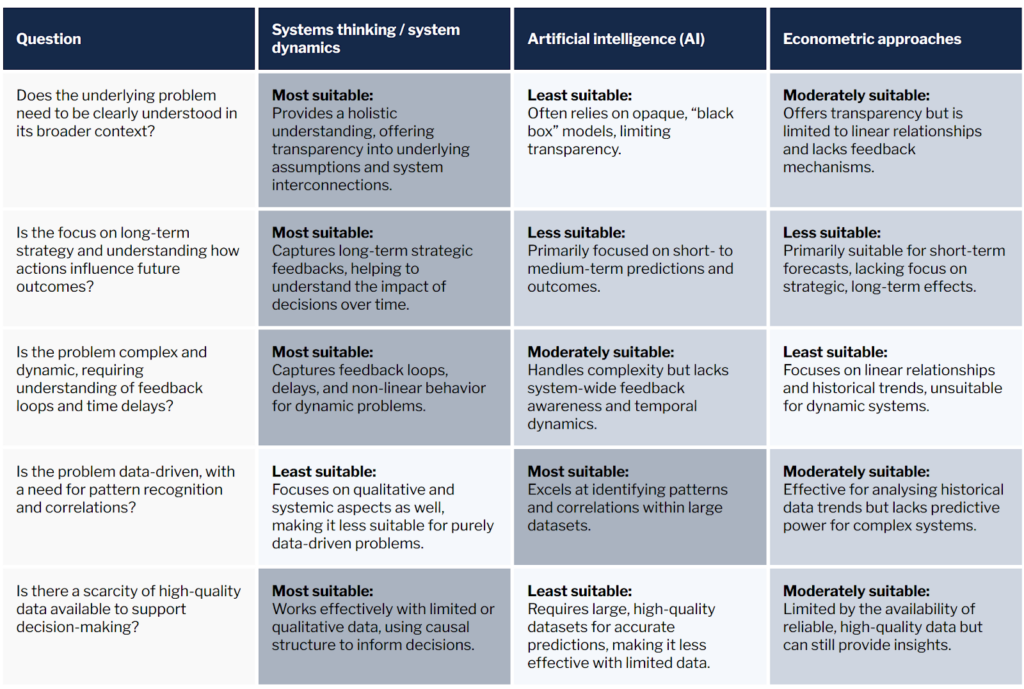
 8.5.2025
8.5.2025
Why does systems thinking support executive decision-making better than AI and econometrics?
In today’s complex business landscape, executives must make high-stakes decisions with long-term consequences. Choosing the right analytical approach is crucial for predicting outcomes, managing uncertainty, and ensuring sustainable success.
While Artificial Intelligence (AI) and econometric models are widely used for data analysis and forecasting, systems thinking and system dynamics provide a unique advantage in addressing complexity, feedback loops, and strategic foresight.
For executives, decision-making is rarely about analysing static data – it’s about understanding how today’s choices will shape the future. Systems thinking and system dynamics provide a holistic, transparent approach that helps leaders make informed strategic decisions, even in uncertain and data-limited situations.
AI and econometric models are powerful tools for operational efficiencies and short-term forecasting. However, they fall short when dealing with non-linear, interconnected business problems that require a deep understanding of causality and long-term impact.
In a nutshell: How different approaches support executive decision-making
1. Artificial Intelligence (AI)
Best for: Identifying patterns in large datasets, making short-term predictions, and automating decisions.
Key Strength: AI excels at finding data-driven correlations, making it useful for operational efficiencies, risk detection, and short-term forecasting.
Limitations: AI often operates as a “black box,” making it difficult to interpret and justify strategic decisions. It also requires large, high-quality datasets, which may not always be available.
2. Econometric models
Best for: Short-term forecasting and analysing historical trends.
Key Strength: Provides structured quantitative analysis and transparency, making it useful for data-driven decision-making.
Limitations: Struggles with dynamic and complex environments as it assumes stable, linear relationships based on past data. It is not ideal for long-term strategy or uncertain conditions.
3. Systems thinking and system dynamics
Best for: Understanding the bigger picture, managing complexity, and long-term strategic planning.
Key Strength: Unlike AI and econometric models, systems-based approach captures the dynamic nature of business problems, showing how different factors interact over time. It helps executives uncover hidden feedback loops, delays, and unintended consequences.
Limitations: It is less effective for raw pattern recognition in large datasets.
The challenge of market forecasting
Mathematical models play a crucial role in business decision-making, serving two primary functions: they either assist in solving specific challenges or help mitigate future uncertainty by providing market outlooks.
However, achieving accurate market forecasts remains a significant challenge – especially in cyclical markets and periods of economic uncertainty. Traditional linear forecasting methods, such as econometric models, often fall short because they are unable to predict market turning points effectively. These methods rely heavily on past trends and struggle to anticipate sudden shifts in demand, competition, or macroeconomic conditions.
Econometrics also fails to provide a comprehensive view of industry dynamics, capture interdependencies, feedback effects, and time delays, which are critical in volatile or rapidly evolving markets.
For executives navigating uncertain market conditions, relying solely on traditional forecasting tools can lead to inaccurate predictions and missed opportunities. This is where systems thinking and system dynamics offer a distinct advantage – helping leaders simulate different scenarios, anticipate disruptions, and develop more resilient strategies.
Each approach has its place
All in all, we can summarise that whereas AI is powerful for real-time insights and pattern recognition, econometric models are effective for historical data analysis and structured forecasting.
When the goal is to understand complexity, gain strategic foresight, and achieve long-term success, systems thinking is essential.
One of the pitfalls of AI is that it stifles critical thinking in the long run. The constant use of AI tools creates lazy thinkers, whose understanding of their own business may become seriously flawed over time.
In a world where business challenges are increasingly interconnected, executives who integrate systems thinking into their decision-making will gain a competitive edge by anticipating future challenges and crafting more resilient strategies.

Would you like to explore how systems thinking can help your leadership team make better strategic decisions? Let’s start the conversation!


